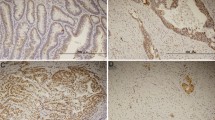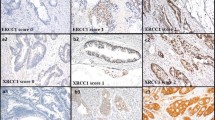Abstract
The tumour-suppressor gene p53 encodes a transcription factor that plays a critical role in the induction of G1 cell cycle arrest and apoptosis after DNA damage. To clarify the role of the p53 gene and apoptosis in combined hyperthermia, chemotherapy and radiation (hyperthermochemoradiotherapy, HCR therapy) for rectal cancer, we examined the histological response, rate of apoptosis, DNA fragmentation and p53 status in tumours from 28 patients undergoing HCR therapy before surgery and from 22 patients who did not have preoperative treatment. The therapeutic effect of HCR therapy was closely correlated with the rate of apoptosis; the correlation was statistically significant, suggesting that this effect occurs through apoptosis. The incidence of p53 mutations in the treated group were as follows: in tumours resistant to HCR therapy, four of seven (57.1%); intermediately sensitive, 7 of 13 (53.9%); or sensitive, three of eight (37.5%), suggesting that the therapeutic effect and apoptosis rate were related to the p53 status of the tumours to some extent, but the relation was not statistically significant. In the 22 control tumours (non-treated group), the apoptosis rate was 2.0 +/- 1.1%, and there was no significant difference in p53 status compared with the HCR group. Our study indicates that the pathological response to HCR therapy correlates with the rate of apoptosis with statistical significance and that it induces the therapeutic effect more significantly in rectal cancer cells with wild-type p53, although HCR therapy-induced apoptosis also occurs in some rectal cancers with mutated p53. Therefore, this combination therapy can induce an additive or synergistic anti-tumour effect in rectal cancers with wild-type p53 as well as in those with mutated p53 through apoptosis, offering new therapeutic opportunities and a better prognosis.
Similar content being viewed by others
Author information
Authors and Affiliations
Rights and permissions
About this article
Cite this article
Sakakura, C., Koide, K., Ichikawa, D. et al. Analysis of histological therapeutic effect, apoptosis rate and p53 status after combined treatment with radiation, hyperthermia and 5-fluorouracil suppositories for advanced rectal cancers. Br J Cancer 77, 159–166 (1998). https://doi.org/10.1038/bjc.1998.25
Issue Date:
DOI: https://doi.org/10.1038/bjc.1998.25
- Springer Nature Limited
This article is cited by
-
p53 dynamics in single cells are temperature-sensitive
Scientific Reports (2020)
-
Germline and somatic genetic predictors of pathological response in neoadjuvant settings of rectal and esophageal cancers: systematic review and meta-analysis
The Pharmacogenomics Journal (2016)
-
P53 abnormalities and outcomes in colorectal cancer: a systematic review
British Journal of Cancer (2005)
-
Apoptosis in oncology
Cell Research (2001)
-
p53, BCL-2, and Ki-67 Expression According to Tumor Response After Concurrent Chemoradiotherapy for Advanced Rectal Cancer
Annals of Surgical Oncology (2001)




